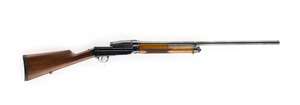Sjögren shotgun
| Sjögren Shotgun | |
|---|---|
 A Sjögren shotgun on display | |
| Type | Semi-automatic shotgun |
| Place of origin | Sweden |
| Service history | |
| Used by | Norway |
| Wars |
World War I World War II |
| Production history | |
| Designed | Patents issued in 1900, 1903 and 1905[1] |
| Manufacturer |
AB Svenska Vapen- och Ammunitions Fabriken, Stockholm[1] Håndvåbenværkstederne Kjöbenhavn, Copenhagen |
| Produced | 1908–1909 |
| No. built | ~5,000 |
| Specifications | |
| Cartridge | 12 gauge |
| Action | recoil |
| Feed system | 5-round internal magazine, tubular magazine on shotgun, box magazine on rifle |
| Sights | bead |
The Sjögren Inertia Shotgun was a 12 gauge semi-automatic shotgun designed by the Swedish inventor Carl Axel Theodor Sjögren, initially manufactured by AB Svenska Vapen- och Ammunitionsfabriken in Sweden and then by Håndvåbenværkstederne Kjöbenhavn in Denmark.[1][2] It used an inertia system later revived by the Italian firm Benelli and today widely used in shotguns. It saw very limited service in World War I by both the allies and the central powers, and service with other armies and resistance groups of the interwar period and World War II. A small number of semi-automatic military rifles in 7.63mm calibre based on the Swedish mauser using the Sjögren system, fed from internal five round magazines, were also built, and tested by potential buyers, but found no market.[1]
References
- 1 2 3 4 Forgotten Weapons, Retrieved 29 February 2016.
- ↑ Gundigest.com. Retrieved 29 February 2016.
- (1972). Guns Review (11).
- "Sjögren Automatic Rifles". Hansard, Volume 198. 10 December 1908
- material from Forgotten Weapons #1
- material from Forgotten Weapons #2
- http://www.guns.com/2012/06/16/forgotten-weapons-sjogren-shotgun-rifle/
- Marsh, Roger. (1947). "The Sjögren Shotgun and Sjögren Military Rifle". The Weapon Series (6).
- Peterson, Phillip. (2010). "Gun Collector’s Corner - Sjögren, The First 12-Gauge Auto". Gun Digest (11).
- Bates, James. (1977). "Sjögren Weapons - part I". The Gun Report (10).
- Bates, James. (1977). "Sjögren Weapons - part II". The Gun Report (11).